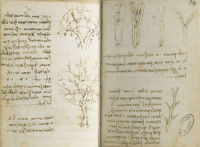Rule of Mathematics Click on the thumbnails to explore the trail
Read more about this trail (expand)
Leonardo believed that all things in nature were governed by mathematics. Mathematics was of supreme importance and expressed incontrovertible, universal truth. Knowledge of mathematics was a prerequisite for understanding the nature of all things. “Let no-one who is not a mathematician read my principles”, Leonardo said. Geometry and its actual or potential relationship to natural forms provided a suitably visual means for the exploration of mathematical “truths”.

- Enlarge
- Zoom & explore
- Fol 78v-79r - Diagrammatic drawing of the growth of trees. Photo RMN - © René-Gabriel Ojéda
Paris Manuscript M Late 1490s-1500
According to Leonardo all things in nature were governed by mathematical rule. Even the growth patterns and forms of plants were conditioned by mathematical principals and geometry.
On Fol 78v, Leonardo claimed that each year when the branches of plants have concluded their maturation, when added together, the sum total of their cross-section is equal to the cross-section of the trunk.
In the accompanying drawing, he illustrated the principle by applying geometry to the problem. In the upper diagram, a tree is shown intersected by a series of arcs centred on the same point located on the trunk. Each of the arcs represents a “degree of ramification” at various points labelled ik, gh, ef, cd and ab.
The diagram illustrates Leonardo’s theory that the cross-sectional areas of the branches will all be “equal among themselves as long as the tree is not deformed”. In the lower diagram, the branches of the tree are enclosed within an “analytical circle” in order to illustrate how the “ramifications proceed radially from a point at the centre of the crown of the tree”, marked m.
In Leonardo's words
The elements of mathematics, that is to say number and measure, termed arithmetic and geometry, discourse with supreme truth on discontinuous and continuous
quantities. Here no one argues that twice three makes more or less than six, nor that a triangle has angles smaller than two right angles, but with eternal silence, every
dissension is destroyed, and in tranquility these sciences are relished by their devotees.
The smallest of Leonardo’s surviving manuscripts, Manuscript M focuses on the study of Euclid’s geometry, ballistics and botany, with important theories regarding the growth of trees.
This notebook also provides evidence of Leonardo’s contacts with Donato Bramante, who became the most important high Renaissance architect, and designer of the new St. Peter’s Basilica in Rome.
The manuscript consists of 48 folios in their original binding.
- Medium Pen and ink on paper
- Size 10 x 7 cm
- Location Bibliothèque de l’Institut de France










